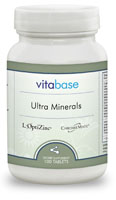| |
Copper supplements |
|
Copper is essential in all higher plants and animals. Copper is the third most abundant trace mineral in the human body. Copper is carried mostly in the bloodstream on a plasma protein called ceruloplasmin. When copper is first absorbed in the gut it is transported to the liver bound to albumin. Copper is found in a variety of enzymes, including the copper centers of cytochrome c oxidase, the Cu-Zn containing enzyme superoxide dismutase, and is the central metal in the oxygen carrying pigment hemocyanin. The blood of the horseshoe crab, Limulus polyphemus uses copper rather than iron for oxygen transport. It is believed that zinc and copper compete for absorption in the digestive tract so that a diet that is excessive in one of these minerals may result in a deficiency in the other.
|
| |
Biological functions and health benefits of copper |
|
|
The body needs copper for normal growth and health. Copper is needed to help body use iron. It is also important for nerve function, bone growth, and to help body use sugar. Copper is a component of or a cofactor for approximately 50 different enzymes. These enzymes need copper to function properly. Copper is an essential nutrient that plays a role in the production of hemoglobin, myelin, collagen, and melanin. Copper also works with vitamin C to help make a component of connective tissue known as elastin. Copper is a critical functional component of a number of essential enzymes, known as cuproenzymes. Copper is an essential component of the natural dark pigment, melanin, that colors skin, hair, and eyes. The cuproenzyme, tyrosinase, is required for the formation of the pigment melanin. Melanin is formed in cells called melanocytes and plays a role in the pigmentation of the hair, skin, and eyes. Copper is a strong antioxidant. It works together with an antioxidant enzyme, superoxide dismutase (SOD), to protect cell membranes form being destroyed by free radicals. Copper is needed to make adenosine triphosphate (ATP), the energy the body runs on. Copper may play a role in staving off heart rhythm disorders (arrhythmias) and high blood pressure. Copper's anti-inflammatory actions may help in reducing arthritis symptoms. |
| |
Dietary sources of copper |
|
| Copper is found in various foods, including organ meats (especially liver), seafoods, beans, nuts, and whole-grains. Additional copper can come from drinking water from copper pipes, using copper cookware, and eating farm products sprayed with copper-containing chemicals. The best source of copper is oysters. Copper may be decreased in foods that have high acid content and are stored in tin cans for a long time. Copper supplements are available as cupric oxide, copper gluconate, copper sulfate, and copper amino acid chelates. |
| |
Dosage, intake, recommended daily allowance (RDA) |
|
Normal daily recommended intakes are generally defined as follows:
Infants birth to 6 months: 200 mcg
Infants 7 to 12 months: 220 mcg
Children 1 to 3 years: 340 mcg
Children 4 to 8 years: 440 mcg
Children 9 to 13 years: 700 mcg
Children 14 to 18 years: 890 mcg
19 years and older: 900 mcg
Pregnant females: 1000 mcg
Breastfeeding females: 1,300 mcg |
| |
Copper deficiency symptoms |
|
Deficiency in humans is rare but it does occur under certain circumstances. Symptoms of possible copper deficiency include anemia, low body temperature, bone fractures and osteoporosis, prominently dilated veins, low white blood cell count, irregular heartbeat, high cholesterol levels, increased susceptibility to infections, birth defects, loss of pigment from the skin, and thyroid disorders. Inherited copper deficiency (Menkes' syndrome) occurs in male infants who have inherited a mutant X-linked gene, with an incidence of about 1 in 50,000 live births. Children with Menkes' disease are unable to absorb copper normally and become severely deficient unless medically treated early in life. |
| |
Side effects, precautions, toxicity, and drug interactions |
|
All copper compounds, unless otherwise known, should be treated as if they were toxic. Symptoms of acute copper toxicity include abdominal pain, nausea, vomiting, and diarrhea, which help prevent additional ingestion and absorption of copper. More serious signs of acute copper toxicity include severe liver damage, kidney failure, coma, and death. 30g of copper sulfate is potentially lethal in humans. The suggested safe level of copper in drinking water for humans varies depending on the source, but tends to be pegged at 1.5 to 2 mg/l. The DRI Tolerable Upper Intake Level for adults of dietary copper from all sources is 10 mg/day. Supplemental copper is contraindicated in those with Wilson's disease (hepatolenticular degeneration), a disease of abnormal copper accumulation. |
|
|
|
|
 Minerals are divided into two classes: macrominerals and trace minerals. Macrominerals are needed in larger amounts than trace minerals. Ultra Minerals by Vitabase includes the macrominerals calcium, magnesium and potassium. Important trace minerals in our supplement are iron, iodine, zinc, selenium, copper, manganese, chromium, molybdenum, vanadium and boron. Many of the minerals are chelated which means they have been bonded to a protein molecule. This helps transport them to the blood stream and enhances absorption at the cellular level. Click here for more information.
Minerals are divided into two classes: macrominerals and trace minerals. Macrominerals are needed in larger amounts than trace minerals. Ultra Minerals by Vitabase includes the macrominerals calcium, magnesium and potassium. Important trace minerals in our supplement are iron, iodine, zinc, selenium, copper, manganese, chromium, molybdenum, vanadium and boron. Many of the minerals are chelated which means they have been bonded to a protein molecule. This helps transport them to the blood stream and enhances absorption at the cellular level. Click here for more information.